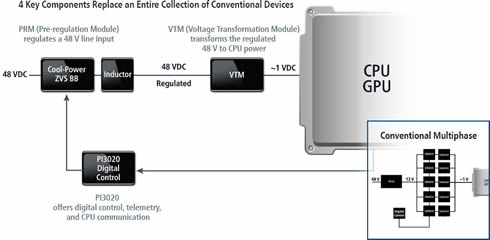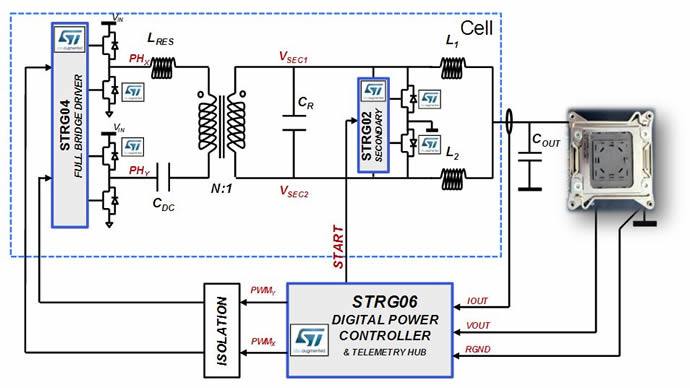Data centre standard helps to save the world’s energy
A new open standard for data centre rack power distribution will potentially save a significant percentage of the world’s energy consumption. Sally Ward-Foxton reports.
According to figures from the American Natural Resource Defense Council (NDRC), data centres in the US consumed 91 billion kWh of electricity in 2013, equivalent to the annual output of 34 large (500MW) coal fired power plants. This is projected to reach 140 billion kWh by 2020 – a staggering amount of energy which represents two percent of the entire world’s electricity production today. There is therefore, a lot to gain by making data centres more efficient. The world would be able to reduce its energy consumption and data centre operators would be able to save millions of dollars.
A new data centre server rack standard is aiming to do exactly this. The Open Compute Project, led by Facebook, has been working on designing a new rack format for some time. The new server rack standard it is proposing is based on Google’s rack design which uses a modular, shallow depth form factor that enables high density deployment of Open Compute Project racks. These racks use a 48V power distribution architecture, which Google claim has already increased the energy efficiency of its racks by 30% and saved millions of dollars, and millions of kWh of energy.
The new standard defines a 48V power architecture which saves energy in three ways. Firstly, by using 48VDC for power distribution rather than the traditional 12VDC that telecom servers have used up to now, I2R losses in the cables and busbars are reduced by a factor of 16 (because four times as much current is required to carry the same amount of power at a voltage four times smaller).

Above: Vicor’s factorised power architecture for 48V direct conversion to point of load versus a conventional multi-phase solution
Secondly, the standard calls for a single power stage to convert from 48V to the 1V or below demanded by CPUs, GPUs, memory and other IC loads. Using a single power stage is much more efficient than multiple stages - if each stage is 90% efficient, ten percent of the power is still wasted at every stage. Reducing the architecture to a single, efficient stage can preserve a lot of this wasted energy. However, this has proved very difficult to achieve, partly because components need to switch incredibly fast for the low duty cycles required to produce such low voltages from 48V, and partly because providing enough power at low voltage for today’s power hungry CPUs means really, really high currents (95A is typical). It has been difficult to produce a suitably compact and efficient design for this single power stage, until recently.
The third way to save energy is really a knock-on effect of the second – if the power supplies are much more efficient, much less heat is radiated and the data centre’s considerable air conditioning requirements can be reduced.
Solutions for 48V-to-PoL
Developing power supplies that can convert 48V directly to point-of-load voltages in a single stage has been challenging, but several manufacturers now have products for this application.
Vicor has developed a 48V rack power solution based on its proprietary factorised power architecture (FPA), see Figure 1 (above). FPA has been around for several years and it’s well suited to applications like this one. The idea is to separate the traditional DC/DC converter plus voltage regulator set-up into a pre-regulator module (PRM) which handles regulation and a current multiplier module (VTM), which handles conversion and isolation.
The PRM generates a controlled ‘factorised’ bus voltage, which the VTM transforms (multiplies) - because the regulation is completed upstream, the VTM can focus on current multiplication or voltage division, allowing it to deliver energy to the load throughout the conversion duty cycle.
Vicor’s 48V direct-to-PoL modules use the company’s Cool-Power PI3751-02 buck-boost pre-regulator module (PRM) plus the VTM48Kp020x current multiplier module (VTM). The PRM uses zero voltage switching to convert its input of up to 55V into a controlled ‘factorised’ bus voltage, providing 240W at 98% efficiency.
This bus voltage is fed to the VTM, which uses zero voltage and zero current switching to multiply the current by 24 while dividing the voltage by 24. The VTM can deliver 95A of continuous current (up to 190A peak current for CPU ‘turbo’ modes for up to 10ms) at 95% peak efficiency.
The advantages of Vicor’s solution include being able to position the PRM at the edge of the board (only the VTM needs to be close to the load) saving space near the CPU for other critical components. And because the VTM’s impedance is so low, fewer bulk capacitors are required at the point of load.
More recently, ST Microelectronics has released a three-chip solution for this application which is now shipping in volume. This novel architecture, which the company calls ‘isolated resonant direct conversion’, is shown in Figure 2 (below). Used with ST’s low voltage StripFET power-MOSFET family, this solution can operate with input voltages between 36 and 72V, producing output voltages between 0.5 and 12V. Efficiency is greater than 97% at 12V/500W.
The ST chipset comprises the STRG02, STRG04 and STRG06. The STRG02 is a secondary-side controller that features predictive zero-voltage and zero-current switching control while allowing power to be sunk during falling adaptive voltage scaling.
The STRG04 is a 60V full bridge which drives MOSFETs or GaN switches at high frequency. The STRG06 is a digital power controller that can manage up to six converters in parallel, supporting output power between 50 and 300W. It is PMBus enabled and offers features such as energy proportional control, adaptive interleaving and current sharing. Reference designs are available.

Above: ST’s chipset enables a novel 48V to point of load architecture which is fully compliant with Intel VR13 requirements for dynamic management of power rails
“ST is already in volume production and supporting this next-generation application with our unique isolated resonant power converters, demonstrating that this solution offers industry leading power efficiency, along with outstanding scalability, and flexibility,” said Matteo LoPresti, Group VP and General Manager Analogue, STMicroelectronics.
Other suppliers throwing their hats into the ring include Maxim, who haven’t revealed much about their solution other than it uses integrated power and magnetics to provide the best possible transient performance, and that it’s Intel VR13 compliant.
“Maxim has a high performance and flexible 48V integrated solution - consistent with what Google proposed at the Open Compute Project Summit - for hyperscale data centre customers to implement later this year,” said Craig Teuscher, Vice President of Cloud and Data Center at Maxim Integrated.
With several designs for single-stage 48V to point-of-load converters emerging in the last few months, the power industry is working hard to provide the next-generation of rack power supplies that meet the Open Compute standard. There are several very different solutions available already but more will emerge as companies come up with innovative ways of converting 48V to 1V.
Since Google claim the architecture it uses today requires 30% less energy to run its servers, once this has filtered down to become the industry standard for data centres, the effect on global power consumption (and the resulting carbon pollution) will be extremely significant.










